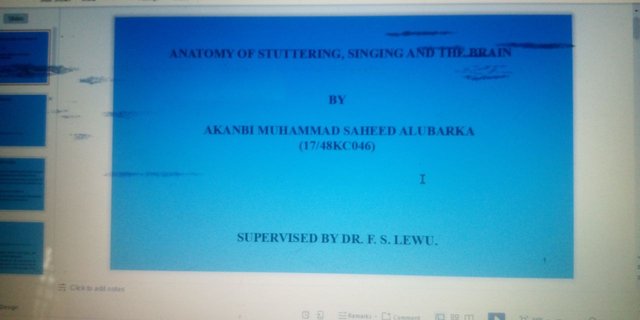"Anatomy of stuttering, singing, and the brain" a seminar i presented to the anatomy department, University of Ilorin, Nigeria. Learn with steemtopus as i share you my experience. | 10% of the rewards to campusconnectng, cheers.

I would love to share something with y'all which was like the last big thing that happened towards the end of last year. As a final year student, we offered a course titled, seminar research. We are all expected to make research about a particular topic, build a write-up, and lastly prepare a presentation slide. All this will be supervised by an assigned lecturer. The presentation will eventually be presented to the department as it is a requirement.
On December 13, we had ours and it seems like it was a sad day for me. But looking back at everything that happened that day, I ought to be grateful. I thought I hadn't done well but it could be dreadful.
I won't share the story but I would love to enlighten us about what I had presented instead.

I presented the "Anatomy of stuttering, singing, and the brain".
Everyone knows that one of the defining characteristics of humans is to make verbal communication that is facilitated by effortless and fluent speech production.
The voice is a complex bio-mechanism and it comprises several body parts adapted for speech and singing. The voice is produced by voice organs which include the lung, the trachea, the larynx consisting the vocal fold and the supraglottal organs in the articulation in the oral cavity, and the pharynx.
To produce the voice, the air is first inhaled, stored in the lungs, and subsequently expelled with the aid of the diaphragm. While being expelled through the larynx, the passage of air creates a pressure difference that causes the vocal folds to vibrate producing the sound waves that become the voice.

WHAT IS STUTTERING?

Stuttering is also called stammering. It is a speech disorder that is found in persons of all ages that can cause disturbances in the normal fluency and time flow of speech.
It is known that people who stutter know what they want to say but just have difficulties in saying them.

INCIDENCE AND PREVALENCE OF STUTTERING

- Affects about 1% of the general population and from 8 to 11% of children (Smith and Weber, 2017).
- About 8% of people experience the onset of stuttering during their lifetime, with boys and men outnumbering girls and women approximately (Smith and Weber, 2017).
- It is estimated that 70 million people worldwide exhibit severe stuttering (Mawson et al., 2016).
- Most children who stutter recover spontaneously (75–80%) within 2–3 years after onset (Koenraads et al., 2019).
- An increased incidence has been noted among individuals who have a relative(e.g. parent, sibling) who stutters (Kraft and Yairi, 2012).

SYMPTOMS AND SIGNS OF STUTTERING

- Repetition of sounds or words.
- Frequency in the extension of sounds.
- Interjections (e.g. um, uh).
- Splitting up words.
- Audible or silent blanks (interruptions during speaking which can be filled or not).
- Indirect speech (using different words to abstain from problematic words).
- Saying the words with extreme physical tension.
- Repetition of one-syllable words (Sari, 2017).
These may be accompanied by secondary characteristics such as;
- Rapid eye blinks.
- Tremors of the lips or jaw.
- Facial tics.
- Head jerks.
- Clenching fists (Maguire, 2020).

I'd stop here and I will continue in my next post to be titled "Anatomy of stuttering, singing, and the brain 2". In the second part, I'll talk about the types of stuttering, causes of stuttering, the genetic bases of stuttering. We will also talk about the relationship between stuttering and singing.
Fun facts:
- Stutterers can sing fluently.
- Singing can help you get rid of stuttering. Ed Sheeran stuttered when he was a kid.
However, singing is not a well-established treatment for stuttering and it has not been adopted anywhere but we'll see. But not to worry, I'll mention the stuttering therapy and the approaches speech pathologists take to reduce stuttering to some certain degree.
I will also mention the functional and neuro-anatomy of developmental stuttering.
Another fun fact is that there is an aberration in some cortical brain structures of individuals who stutter which makes it different from that of fluent people. This aberration however does not reduce the intellectual capabilities of the individual.
I will end part two of this with the social and environmental impacts of stuttering on the affected individual.
I hope you all enjoyed reading my posts. You may have a comment or two, you should drop them in the comment box. You may also want to satisfy your curiosity, feel free to ask questions about the University of Ilorin, anatomy, and stuttering.
Thank you for reading my post.
Regards, @steemtopus.
CC;
@whitestallion
@emmanuel-malume
@dayographix
@davosimple
@swaylee

References
Koenraads, Simone & El Marroun, Hanan & Muetzel, Ryan & Chang, Soo-Eun & Vernooij, M.W. & Baatenburg de jong, Robert & White, Tonya & Franken, Marie-Christine & van der Schroeff, Marc. (2019). Stuttering and gray matter morphometry: A population-based neuroimaging study in young children. Brain and Language. 194. 10.1016/j.bandl.2019.04.008.
Kraft, S. J., & Yairi, E. (2012). Genetic bases of stuttering: the state of the art, 2011. Folia phoniatrics et logopedic: official organ of the International Association of Logopedics and Phoniatrics (IALP), 64(1), 34–47. https://doi.org/10.1159/000331073
Maguire, G. A., Nguyen, D. L., Simonson, K. C., & Kurz, T. L. (2020). The Pharmacologic Treatment of Stuttering and Its Neuropharmacologic Basis. Frontiers in neuroscience, 14, 158. https://doi.org/10.3389/fnins.2020.00158
Mawson, Anthony & Radford, Nola & Jacob, Binu. (2016). Toward a Theory of Stuttering. European Neurology. 76. 244-251. 10.1159/000452215.
Sari, Hakan; Gökdag, Hatice. An Analysis of Difficulties of Children with Stuttering Enrolled in Turkish Primary Inclusive Classes Who Encounter in Academic and Social Activities: From Their Perspectives Journal of Education and Practice, v8 n2 p31-43 2017
Smith, Anne & Weber, Christine. (2017). How Stuttering Develops: The Multifactorial Dynamic Pathways Theory. Journal of speech, language, and hearing research: JSLHR. 60. 1-23. 10.1044/2017_JSLHR-S-16-0343.



A very amazing article
Thank you boss, still learning
I must say this is interesting ✌️
Yes, it is. Thank you for the words
Yo brosev this is amazing. I'm sure the audience you presented it to would be as amazed as I am. You must have really put alot of time into the publication of this post and it is highly appreciated. Steem on brosev
Thank you for seeing that i have done a lot of work. These words means a lot, boss.
Thanks for letting us know the anatomy of stuttering! Nice one
Yes, the topic is an interesting one. I have worked on this research for months now. I appreciate that you enjoyed it.
Amazing!!
I am really impressed. Very neat precise and beautiful referencing. Thanks for sharing. Steem on
I am happy you are impressed. I was also while doing the researches and downloading articles for literature review. Thank you for your comment
What a wonderful article, steem on bro
Thank you bro, steem high!
Damn, I felt like I was reading an essay report. You really did great especially by ending it with your references. From one science student to another, you're awesome
Yes, it was a lot of effort. Thank you for the kind words. Means a lot.